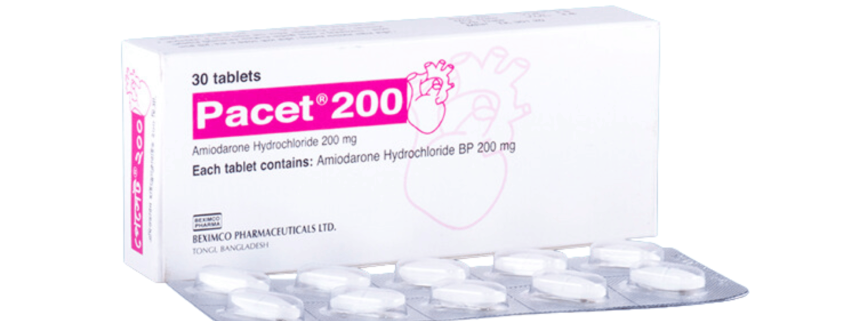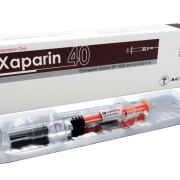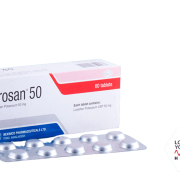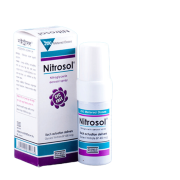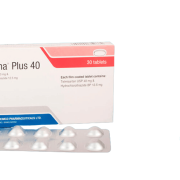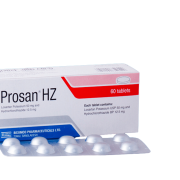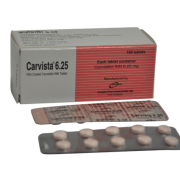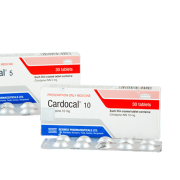Pacet

Generic Name: Amiodarone
Dosage Form: Tablet
TG Name: Cardiovascular
1. What is and what it is used for?
Pacet® is a preparation of Amiodarone. Amiodarone is used to correct abnormal rhythms of the heart (an antiarrhythmic medication). Amiodarone is considered a “broad spectrum” antiarrhythmic medication. Among its most important electrical effects are: a delay in the rate at which the heart’s electrical system “recharges” after the heart contracts (repolarization); a prolongation in the electrical phase during which the heart’s muscle cells are electrically stimulated (action potential); a slowing of the speed of electrical conduction (how fast each individual impulse is conducted through the heart’s electrical system); a reduction in the rapidity of firing of the normal generator of electrical impulses in the heart (the heart’s pacemaker); a slowing of conduction through various specialized electrical pathways (called accessory pathways) which can be responsible for arrhythmias.
In addition to being an antiarrhythmic medication, amiodarone also causes blood vessels to dilate (enlarge). This effect can result in a drop in blood pressure. Because of this effect it also may be of benefit in patients with congestive heart failure.
2. Before you take Pacet®
Do not take this medicine and tell your doctor if:
Amiodarone is contraindicated in patients who are hypersensitive to any component of this product .Do not take this medicine if the above applies to you. If you are not sure, talk to your doctor before taking Dilapress.
Taking other medicines
Amiodarone may interact with beta- blockers such as atenolol, propranolol, metoprolol, or certain calcium-channel blockers, such as verapamil or diltiazem, resulting in an excessively slow heart rate. Amiodarone increases the blood levels of digoxin when the two drugs are given together. Flecainide blood concentrations increase by more than 50% with amiodarone. Procainamide and quinidine concentrations increase by 30-50% during the first week of amiodarone therapy. Amiodarone also can interact with tricyclic antidepressants. Amiodarone interacts with warfarin and increases the risk of bleeding. Amiodarone inhibits the metabolism of dextromethorphan.
Pregnancy and breast-feeding
In general, amiodarone should not be administered during pregnancy because there have been reports of hypo- or hyperthyroidism in infants from oral amiodarone use during pregnancy. If amiodarone use is considered essential, however, the patient should be warned of the risk to the fetus.The safe use of amiodarone in women who are breast-feeding during amiodarone therapy has not been established.
3. How to take Pacet®?
Amiodarone usually is given in several daily doses to minimize stomach upset which is seen more frequently with higher doses. For this same reason, it is also recommended that amiodarone should be taken with meals. Oral dose is 200 mg 3 times daily for 1 week reduced to 200 mg twice daily or the minimum required to control arrhythmia.
If you forget to take Pacet
If you forget to take a dose, take it as soon as you remember it. However, if it is nearly time for the next dose, skip the missed dose. Do not take a double dose to make up for a forgotten dose.
If you stop taking Pacet
Do not stop taking this medicine without talking to your doctor. You should not stop taking Pacet just because you feel better. This is because the problem may come back or get worse again.
If you have any further questions on the use of this product, ask your doctor or pharmacist.
4. Possible side effects
Like all medicines, Enaril can cause side effects, although not everybody gets them.
The most severe side effects of amiodarone therapy are related to the lungs. These reactions can be fatal. Patients should report any symptoms of cough, fever, or painful breathing. Although quite rare, fatal liver toxicity may occur with amiodarone therapy. Reversible corneal microdeposits (sometimes with night glare), rarely impaired vision due to optic neuritis; peripheral neuropathy and myopathy (usually reversible on withdrawal); bradycardia and conduction disturbances; phototoxicity and rarely persistent skin discoloration; hypothyroidism, hyperthyroidism; raised serum transaminases (may require dose reduction or withdrawal if accompanied by acute liver disorders); jaundice, hepatitis and cirrhosis reported; rarely nausea, vomiting, metallic taste, tremor, sweating, vertigo, headache, sleeplessness, fatigue, alopecia, benign raise intracrenial pressure, ataxia, rashes, hypersensitivity including vasculitis, renal involvement and thrombocytopenia; haemolytic or aplastic anaemia. In some cases, dose of amiodarone may be reduced. In other cases, amiodarone therapy may need to be stopped.
Tell your doctor if any of the side effects gets serious or lasts longer than a few days, or if you notice any side effects not listed in this leaflet
5. How to store Pacet®?
Tablets should be kept at room temperature, less than 30°C (86° F).

